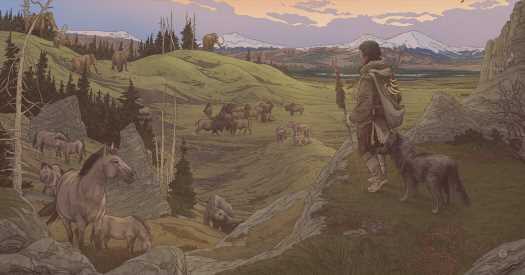
Twenty-three thousand years ago, in the cold of the last ice age, some humans found a place where the climate was marginally better: Siberia.
While many people associate the region that is now in Russia with forbidding cold today, climate data as well as archaeological and DNA evidence show that this was where horses, mammoths and other prey animals found enough to eat, which attracted humans and other carnivores. Hemmed in by worse conditions, the humans, some of them the ancestors of Native Americans, were isolated for thousands of years. So were wolves.
It is there and then that dogs were first domesticated, according to a new hypothesis from a group of archaeologists and ancient DNA experts who specialize in the deep history of humans and canines. They published their analysis on Monday in Proceedings of the National Academy of Sciences.
Angela R. Perri, an archaeologist at Durham University who studies the domestication of dogs, said the new hypothesis emerged in informal discussions among the authors. As they assembled archaeological and DNA data on the peopling of the Americas and the origins of dogs, they came up with an idea that was lurking in the data all along, one that she said, “I’m frankly embarrassed I didn’t have earlier.”
David Meltzer, another author who is an archaeologist at Southern Methodist University in Dallas specializing in the peopling of the Americas, recalled one whiteboard session at Oxford in which he and other authors, including Dr. Perri, brainstormed the complicated chain of reasoning based on DNA evidence that has allowed the tracing of population movement of ancient humans and more recently dogs.
He said to Greger Larson, an Oxford scientist who has orchestrated a number of dog domestication studies, including this one: “I’ve seen your dog dates. And my people dates, they kind of look the same.” By the time the whiteboard was filled, he said, they had the bones of the new paper.
Ancient canine history is murky and in the past decade alone, researchers have suggested Europe, Eurasia, East Asia and Africa as the first home of dogs, starting at least 15,000 years ago. Some researchers push the origin back much further, but whether some of the earliest fossils are dogs or wolves is debated.
A starting point for the new proposal is the date when humans first came to the Americas, probably around 15,000 years ago. Another is that ancient DNA shows that dog and human populations have similar histories of migration and divergence.
Dr. Perri said that among ancient American dogs, which disappeared, leaving only traces of their genetics in a few modern breeds, “there are two main groups which share a common ancestor about 23,000 years ago.”
On the human side there is a similar split.
The names get a bit hard to keep track of, but one group called the Ancient North Siberians mixed with another group from which Ancestral Native Americans split about 21,000 years ago. The hypothesis suggests that in addition to providing some genes, the ancient North Siberians also gave dogs to people, some of whom eventually migrated to North America, taking the dogs with them. As Dr. Meltzer said, “Dogs are not going to go to the new world without people.”
But the several different groups in Siberia appear to have been isolated from outside contact from about 30,000 years ago to 15,000 years ago. So, Dr. Perri said, if there is “this isolated population who had no interaction with anyone outside of Siberia after 30,000 years ago, who gave the dogs to the ancestors of Native Americans?”
The data suggest that it was the ancient North Siberians, who, having been isolated for thousands of years, must have been the people who first domesticated wolves, or with whom wolves domesticated themselves, feeding on leftovers or discards from the hunt.
Dr. Meltzer said these Siberians lived in small groups of 25 or so in a vast, open landscape. Ancient DNA evidence shows that they married outside of their small groups, and so had to seek one another out. “People are exchanging information, they’re exchanging mates, they’re maybe exchanging their wolf pups,” he said.
Pontus Skoglund, an ancient DNA expert who studies the origin of dogs at the Crick Institute in London and was not involved in the research, said, “Siberia could very well be the origin of dogs. Absolutely.” But, he said this was one possibility only. He said the analysis in the paper depended largely on mitochondrial DNA, which traces only the maternal line and is therefore incomplete.
“It’s still an open question for me,” he said. “It could be many other corners of Eurasia as well.”
New information on ancient DNA recovered from Siberian dog fossils that are 18,000 or more years old could help prove or disprove the hypothesis, Dr. Perri said, and she and her colleagues are working on those studies now.
Source: Read Full Article